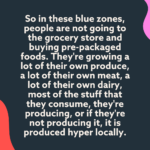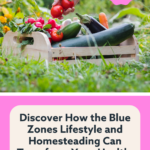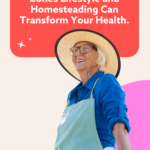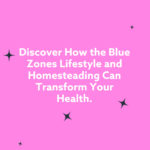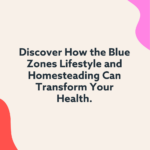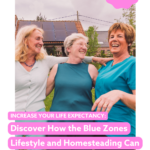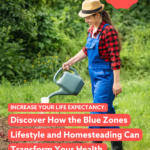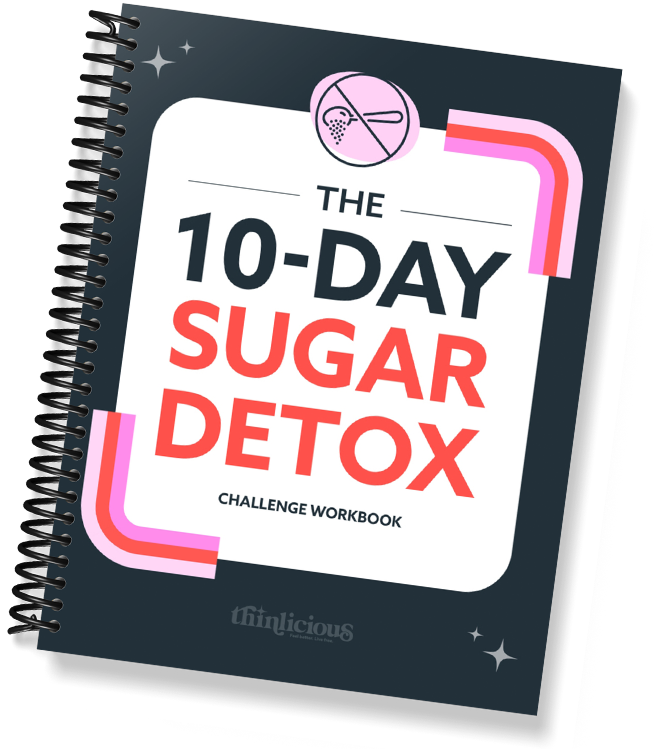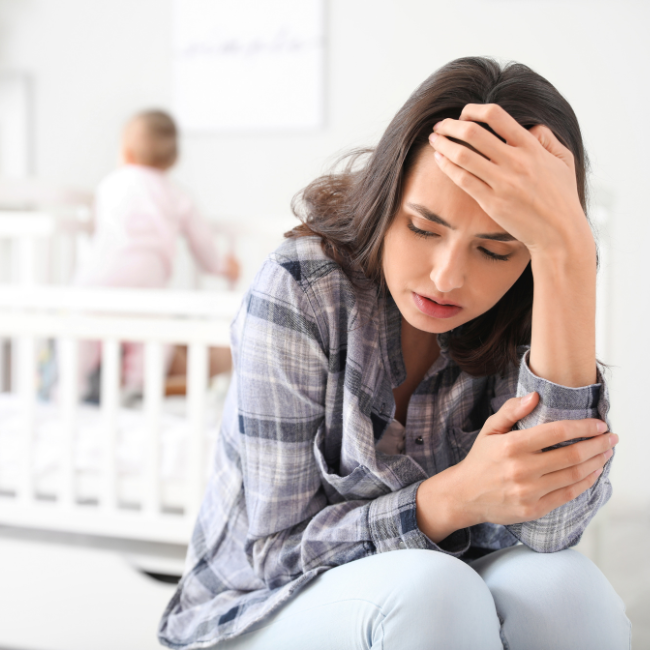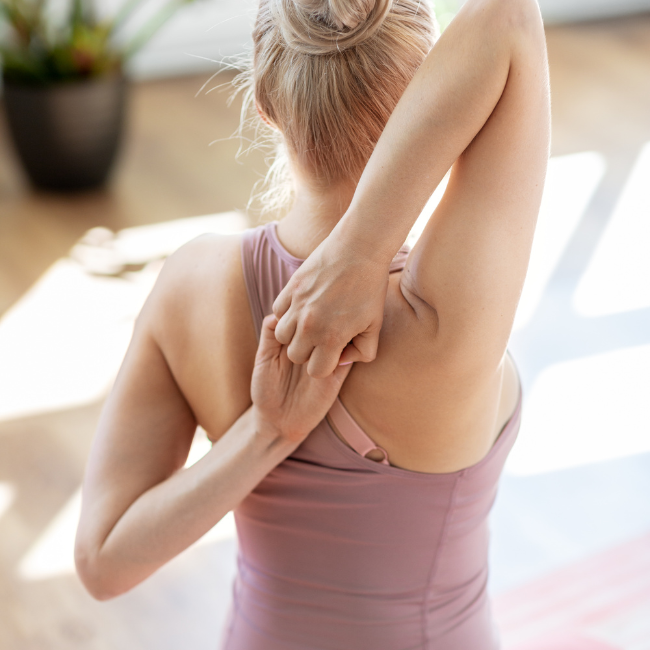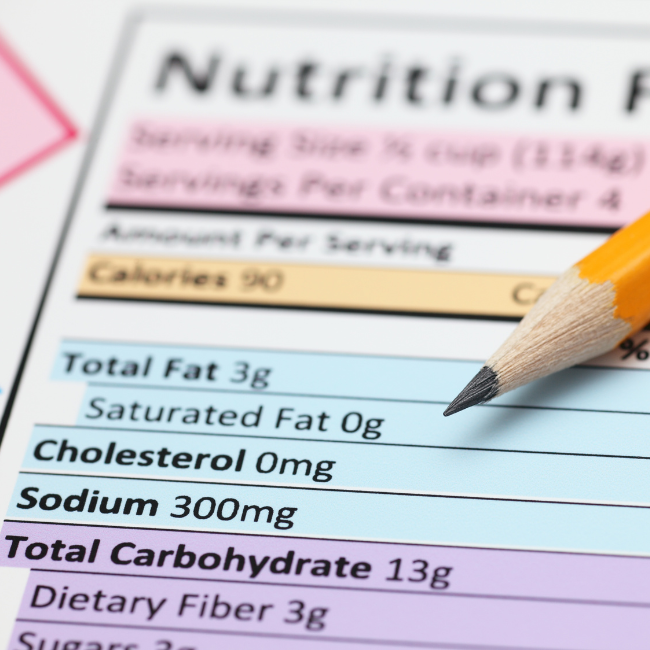Have you ever had one of those near death moments that completely changed your perspective on life? Where your life flashes before your eyes or you suddenly just wake up and realize it’s time to do something different? It may not always happen like in the movies, but those wake up calls do happen.
And sometimes they change everything.
In today’s post, I interview my friend and homesteading expert, Shelby DeVore, about the very scary wake up call that led her down a rabbit hole of research for a better way to live.
What she discovered is so interesting and relevant to every single one of us that I cannot wait for you to dig into today’s post.
Are you ready to lose weight and heal your body for life (without dieting, drugs, or making yourself miserable)?

Our free on-demand video training will walk you through how to make this THE year you set health goals…and keep them.
Shelby DeVore is a homesteading expert and the founder of Garden Farm Thrive. She shares about the insane health scare that changed her whole perspective on homesteading and on the food that we eat. You’re truly not even going to believe what’s happened to her.
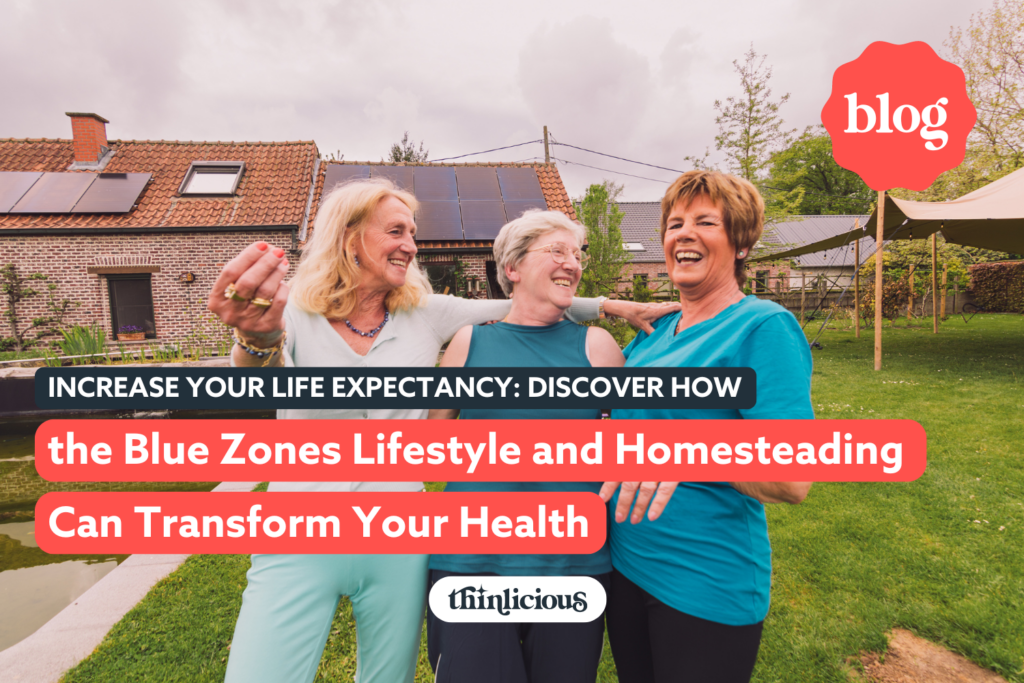
But before we get to that, I want to tell you quickly about one quick thing. If you are new here and you’re just trying to learn more about how to get healthy or lose weight in a healthy and sustainable way, I would love to send you our free starter guide. It is super helpful for understanding just a little bit of the science behind the topics that we cover here and why, if you’ve reached a certain age, it might feel like your metabolism has stopped working.
If you want that, you can grab it at thinlicious.com/guide
Now, I am so excited to be able to introduce you to today’s interview guest, Shelby DeVore.
Ruth: Well, hi, Shelby. Thanks so much for being here. I’m super, super excited to talk to you about all things homesteading and blue zones and all of it. So why don’t we just start with a little bit of an intro. Who you are, what you do, how you got to be doing what you’re doing.
Shelby: I’m super excited to talk about all of the things with you today too. My name is Shelby DeVore and I’m the founder of Garden Farm Thrive where we teach homesteading.
Let’s see, I hated the term homesteader for a long time because I grew up this way. I guess I’m what you would call a multi generational homesteader, which is nice to say, but for a long time I was like, I’m not like prepping or getting ready for like the zombie apocalypse or anything.
I think sometimes people put the two things together, right?
But to back up, before I started my online business, I taught high school and college agriculture classes. I have a bachelor’s degree in animal and dairy science. I have a master’s degree in agriculture. And, if there is any topic that is agriculture or growing your own food related,
I’ve probably taught it formally at some point. Bringing all of that into our business now felt kind of seamless. It was a lot of the same stuff that we were teaching in a classroom, just in an online setting now, which is nice because I’m actually able to teach people who want to learn.
So, yeah, that’s kind of how we got to where we are today.
Ruth: That’s awesome. I didn’t even know that about you! That’s impressive. So when I see all of your stuff, I’m like, “Oh my gosh, you make me want to homestead because I have this dream.”
We bought this farm six, seven months ago. And I have a dream where we’re going to have chickens. I want to have cows. I want to have a garden. My husband is like, “honey, every time you’ve tried to garden, it’s been a disaster.” I’m like, “but this time, this time it’s going to be real.”
But now I’m like, “I got Shelby. I got Shelby as my backup plan.” You’re going to be my guru.
Shelby: Let’s do it. I was so pumped when you posted that you had purchased a farm. I was like, yes. This is amazing. There’s so much stuff that you can do. It’s so much fun. I can’t wait. I honestly can’t wait.
Ruth: My daughter wants to homeschool next year. So I’m like, okay, you can homeschool, but we’re going to do outside projects. You’re not just going to be on the computer all day. So we’re going to be forced to get some chickens for our homeschool.
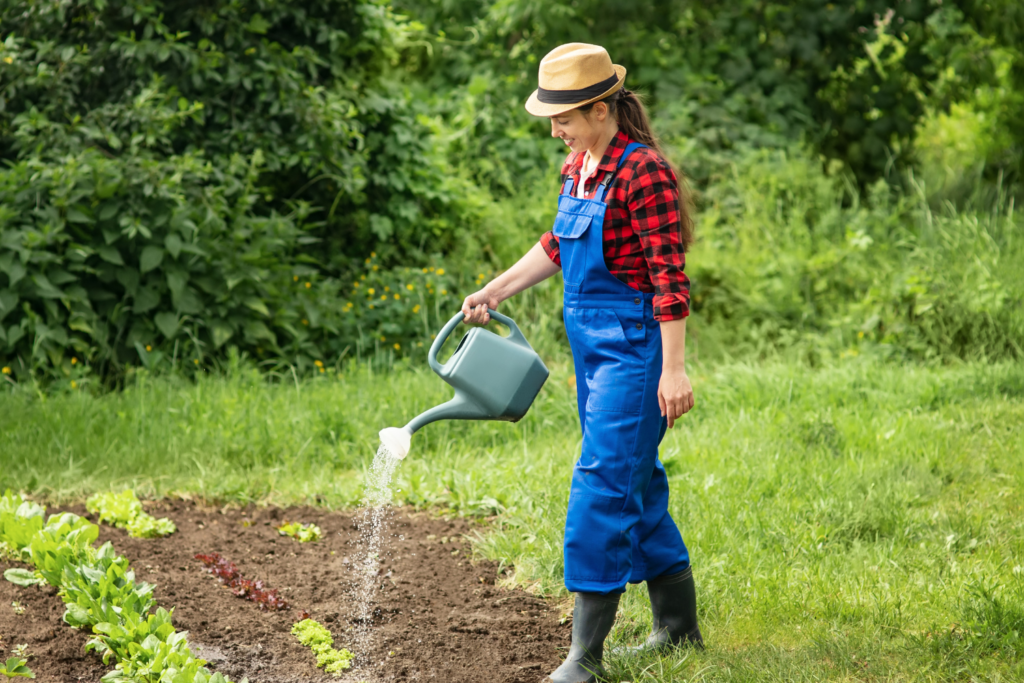
Shelby: That is so much fun. I’m so pumped for you. You guys are going to love it.
Ruth: Okay. So let’s talk about you and your health scare, because you had a health scare a few years ago that sort of led you down this rabbit hole of research. So what happened?
Shelby: So it was totally unexpected, which I think most people who have had a health scare, they would probably say that.
Like I said, I grew up in this lifestyle and people tend to associate homesteading with being healthy anyways. You’re growing a lot of your own food, you’re making things from scratch, you spend a lot of time outside.
It’s a fairly healthy lifestyle compared to modern western lifestyles. I always thought I was pretty healthy when we would go to doctor’s visits or checkups or whatever. No red flags. I was never on a prescription medication or anything. But a little over three years ago, I started having some chest pain.
And honestly, I felt like I was getting pneumonia or just a really nasty chest cold. My husband and I actually joked about it. We were like, it’s probably COVID. Cause everything was COVID back then.
But as the day went on, I felt worse and worse and worse.
My husband came home from work and by this point I was almost unconscious on the couch. My kids were just doing whatever because we were homeschooling at the time. So he came home and I don’t really remember this, but he said he could tell something was seriously off. He cooked dinner that night, got the kids in the bed and I don’t remember any of this.
He had me take some aspirin. I’m so lucky that he even thought about that because the next morning I woke up and I had like radiating chest pain through my neck and my arm and I know.
I went to the doctor and I was thinking my dad was on blood pressure medicine, so I was thinking maybe, you know, I have to be on blood pressure medicine. I’m 30, like they say, this is when stuff starts going downhill. Like maybe this is just my life now. And I went to the doctor thinking he was going to give me a prescription. I’d get to go back home.
But I was having a heart attack. Something you don’t think about happening to you, especially when you’re considered healthy and 30 years old.
So I had a heart attack and the scary part about it was, it wasn’t your typical type of heart attack. It was a spontaneous coronary artery dissection, which means your arteries just kind of fall apart and your heart freaks out. It happened in two different places and it was really hard for them to diagnose it.
To diagnose, they have to do a protein test. I had to go through literally every single test to diagnose it and an invasive procedure to actually be able to see it. So I was in the hospital for several hours, actively having a heart attack, which led to me having a stroke in the hospital.
And when that finally happened, I guess that was a clue to them as to what was going on and they were able to diagnose it. Then treat it pretty quickly.
Ruth: So did you have to go right into surgery?
Shelby: I did. It’s insane because I’m allergic to the type of dye that they use to see the imaging for this procedure. I will never forget because I was freaking out. All of this stuff is happening and I had this really great cardiologist. He was one of the best in the area, but he had the worst bedside manner. He was a great doctor, horrible to talk to.
He came in and was like, “Well, we think we know what’s going on. We need to run one more test and we’ll be able to fix it while we’re in there. The only thing is, it’s an invasive test and not typical like an x ray or an ultrasound. We have to p p this dye into your heart and your chart says that you’re allergic to this dye.”
And I’m like, “So can you do that? Like, how does this work? You’re pumping this into my heart.”
And he said, “We’ll counteract it with different drugs. This is the only option.”
My husband and I were like, “okay, I guess we’re doing this.” So he turns to walk out of the room. literally stops in the doorway and goes, “Oh, and legally, I do have to tell you that one to two percent of people that go through this procedure don’t come out alive.”
And he just walks away.
Like, oh my gosh, that was it. The nurse was sitting there and I was like, “wait, does that mean I am more at risk? Because I’m allergic to the… like, what is going on? Did he really have to say that?”
So it was traumatic to say the least. But obviously I survived. I was, I guess, one of the 98 percent of people that survived.
Ruth: So what did that change for you then?
Shelby: Oh my gosh, so much. One of the things that you tend to associate with having a heart attack is being under a lot of stress and your diet and health, that kind of stuff.
We obviously had a million questions for our cardiologist. Like, what caused this? What was the underlying factor? And, like I mentioned, it wasn’t a typical type of heart attack. So, when they did all of my blood work, my stuff actually looked great. There’s nothing they could pinpoint that would trigger it.
So as we were talking to the doctors, they said they really think this type of heart attack could be related to hormones. But it’s so rare they don’t really know. The only thing that they did say was once you have one of these, they tend to repeat themselves. So my risk of having another was like one out of three every two years… and the risk never goes away.
So that led to the question of, what do I need to do to either prevent myself from having a heart attack or if it happens again, surviving… because I feel like I got lucky with the first one, right? I ended up getting into a pretty deep conversation with my cardiologist that day.
When I was in the physical therapy room with like all of the 80 year old people that are there for cardiology, physical therapy, and we were just discussing different things and he said, “I think you should look into some of the research around blue zones. They have much higher life expectancy than other areas and it’s not a diet.”
He said, “if I were you, I would be researching that because they’re obviously doing something right in these blue zones. That really led me down this rabbit hole of all of this research that I’ve uncovered about blue zones and health and all the good stuff.
Ruth: Well tell us what is a blue zone?
Shelby: The reason it’s called a blue zone is because researchers that study h an aging and life expectancy, they identified, depending on the research, five or six areas in the world. They’re very small areas where people have much higher than average life expectancy.
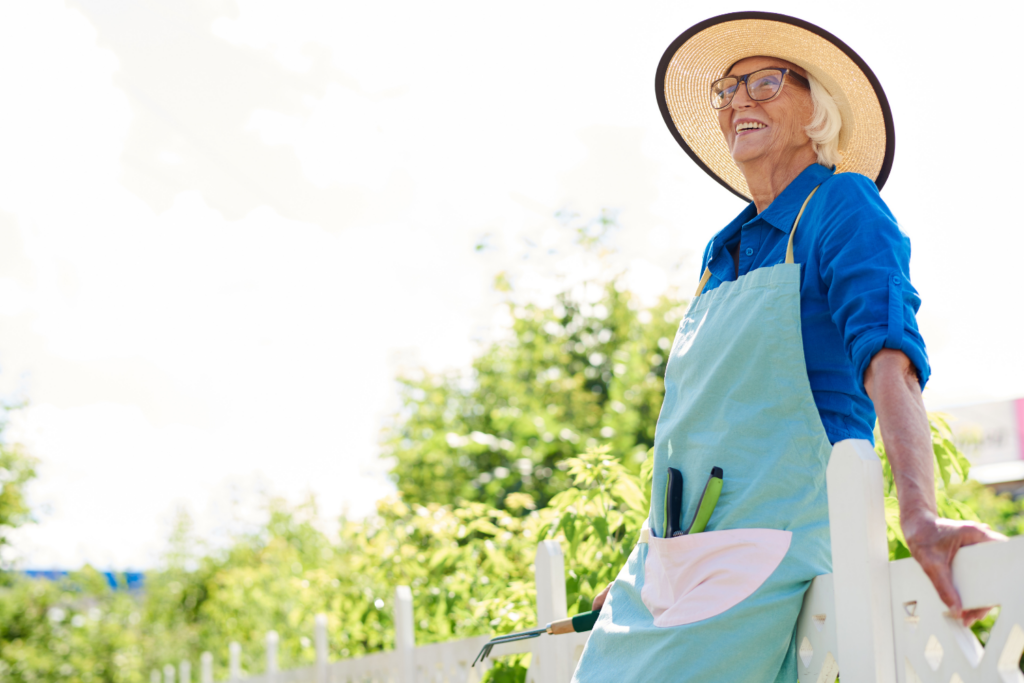
We’re talking, these people are living like 20 years above the average life expectancy, and they also have much higher rates of centenarians, which are people that live to be over 100 years old. So as they identified these different areas, they literally took a map, and one of the researchers had a blue pen, and they circled all these different areas, which is why they’re called blue zones.
What they uncovered when they started digging into what these people are doing that is causing them to live so much longer is just, it’s mind blowing. So, at first researchers thought maybe it has to do with, like, good genetics, right? Like maybe we’ve identified these pockets of people that have just been blessed with good genes, right?
So the first thing they did was they started to research their genetics. They did a bunch of DNA testing to see if they shared genes that are related to higher than average life expectancy. And they found that’s actually not the case at all. Less than 1 percent of these people had genes that are related to higher life expectancy.
So if it’s not genetics, That means it’s something that they are doing in their life. It’s their lifestyle, right? So they eliminated genetics and they started diving into what these people are doing that modern society outside of these blue zones are not doing? And they started digging into some of that.
And this is where I get super excited because there’s so much overlap with what people are doing that are living in blue zones and what homesteaders are striving to accomplish. It’s so freaking good.
Ruth: Okay. So tell me!
Shelby: So when we think about homesteading, we think about growing and producing more of your own food. People are more of the old fashioned mindset, right? Like one of the big draws about homesteading is people want to keep these traditional skills alive.
So keep that in the back of your brain. When we look at blue zones, there are a few different pillars of things that these people are doing that almost essentially line up exactly with homesteading.
So in these blue zones, people are not going to the grocery store and buying pre-packaged foods. They’re growing a lot of their own produce, a lot of their own meat, a lot of their own dairy, most of the stuff that they cons e, they’re producing, or if they’re not producing it, it is produced hyper locally.
So for example, let’s say you and I were neighbors and I have a huge garden patch in my backyard, but I don’t have chickens. You don’t have a garden, but you have chickens. And so what we would do is just swap out what we needed and provide it for each other, right? That’s kind of what’s going on in these blue zones.
Most of the people have some sort of garden going on. And then everything else that they’re not producing, again, they’re getting it extremely locally. It’s fresh, it’s grown organically and sustainably. It’s not being shipped in and that means it’s a lot more nutrient dense, right? So just the quality of what they’re eating is so much better for them.
Which leads to another point in one of the pillars of blue zone lifestyles. These people, when you think about exercise, typically what comes to mind is what we call explosive exercise, right? Like lifting weights for 30 minutes, going to hot yoga or biking or running. And we think of exercise as, “how many calories can I burn in a short window of time?”
People that live in blue zones, they’re not doing explosive forms of exercise. Like, that’s not part of their agenda at all. They’re just way more active consistently throughout the day. And one of the major forms of exercise that these people are getting is taking care of a garden.
We would never think of that as exercise. But that’s one of the major forms of exercise that these people are getting. And it’s accumulated throughout the day, keeping their body busy, keeping their body going.
They’re not sedentary the same way that most people are these days.
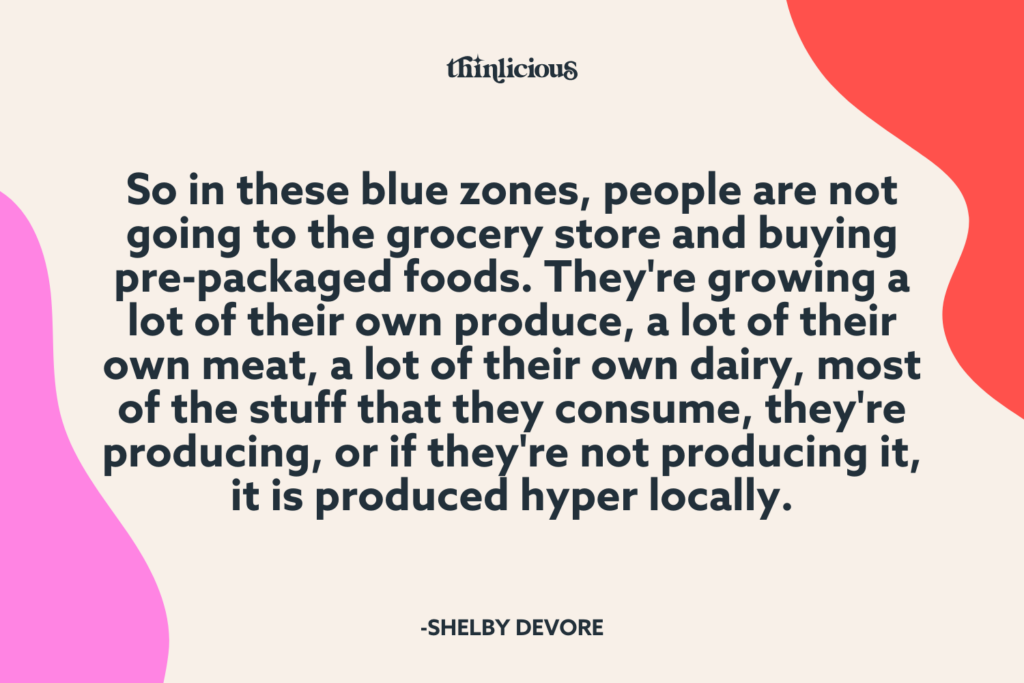
So those were two big things. As I started diving into the research, I was thinking, “this is literally homesteading. Produce more of your own food, get outside, take care of your garden, and be a little bit more active.” And then they’re also huge on tradition, which again, homesteaders can totally relate to this.
I think a lot of people that are interested in homesteading are interested in that simpler, more old fashioned lifestyle, right? They like the idea of a slow afternoon baking sourdough or sitting on the porch drinking coffee watching their chickens. People that live in blue zones love tradition, and they work really hard to keep tradition alive.
And that also comes back to traditional foods. In these blue zones, they’re not eating ice cream sandwiches and modern packaged junk. They’re using these older recipes that have been around for generation after generation. If you look into it, a lot of it is, again, not just the more nutrient dense food that they’re producing, but it’s also a lot of gut healthy food, right?
One of the Blue Zones is in Japan. They love to eat kimchi. Like that’s one of their traditional foods. And, you know, it’s super gut healthy. Any of those fermented foods are. So when you look at the different blue zones, they all have some sort of traditional staple in their diet that is kind of on the same lines as kimchi would be.
It was just fascinating. When I started digging into this, I was like, yeah, blue zones are like modern homesteading.
Ruth: That’s exactly what it sounds like. And a lot of the same stuff that we talk about all the time on this podcast, right? Like cutting out or eating nutrient dense foods and eating food as close to nature as possible and getting outside more and spending time in the sunshine.
And it’s like, not really about exercise. It’s about the total lifestyle. And that’s incredible.
But I’ve never equated it to the homesteading thing. And it makes me want to homestead even more. So how does somebody create their own blue zone?
Because here we are, life is busy. Not all of us have enough time to start a garden or the space to have cows, right? How do you create your own blue zone when living in America?
Shelby: Yeah. So this is where I get super excited because I think people overcomplicate homesteading way more than they should. So if we look back to say a hundred years ago, the standard American diet looked extremely different than it does today, right?
That’s largely in part because they didn’t have grocery stores the way we do now. They didn’t have big commercial farms. They didn’t have these giant food companies. Those weren’t really a thing yet.
Ruth: Oh my gosh. Yes. Pumping our bodies full of chemicals.
Shelby: Right. That stuff did not really exist yet.
We didn’t start to see that stuff take off until a little over a hundred years ago. Most people grew and produced the majority of what they ate, or, again, got it from a really local source, right? They might get their meat from a local butcher shop or something, but everything was very local. So what happened was, as grocery stores started to emerge, as big food companies started to emerge, they identified that there was one group of people that was standing in their way between them making a ton of money and that was the housewife. Because back then, she was the one that was taking care of the garden. She was the one that was making all of this stuff from scratch. And so it’s actually mind blowing if you look at advertisements that circulated in the early 1900s. So much of the ads that went through magazines and newspapers were literally targeted at housewives. One of my not so favorite headlines is a headline for an ad that said a tired wife makes a poor wife.
And if you read the article, it starts to tell them that the reason they’re so tired when their husband gets home is because they’re busy taking care of the garden and doing all of these things. It super over exaggerated what these ladies were doing, right?
This went on for like, 10 years, and within that 10 year time period, they essentially convinced an entire generation of women that this was too much work, it was too hard, they didn’t have time and that their life would be so much simpler if they just quit doing it and shopped at the grocery store.
So that’s what happened.
Ruth: So what you’re saying is big food has been conspiring against us for more than 50 years.
Shelby: Um, a hundred years. Ha.
Ruth: It’s like, since the beginning. Don’t even get started on that. Shelby, let’s not go down that rabbit hole!
Shelby: So to come back to your original question, how can we create this blue zone?
Again, I think people over-complicate what you have to do in order to have a massive impact on your health. And we tend to think of homesteading as like being 100 percent self-sufficient. A lot of people tie those two things together and you don’t have to be self-sufficient to see major impacts on what you can do for yourself.
So I think making sure that you look at homesteading and ask how can I go about this in a way that is sustainable for me and my family in the long run? And just acknowledging that doing it to be completely self sufficient is a goal that people are never actually going to be able to attain.
If you’re being realistic about it, you’re not gonna have the cows. You’re not gonna have the huge garden. You’re not gonna be able to grow your own wheat and sugarcane. I teach people to look at homesteading from a simplistic view.
And when I say that, I don’t mean to make our lives like Little House on the Prairie, but how can you make homesteading work for your family? What can you do that isn’t going to completely overhaul your schedule but is actually sustainable for you? For a lot of people that’s something simple like starting with a garden, right?
You would be amazed at what you can grow on like a postage stamp. It’s not as time consuming if you do it the right way.
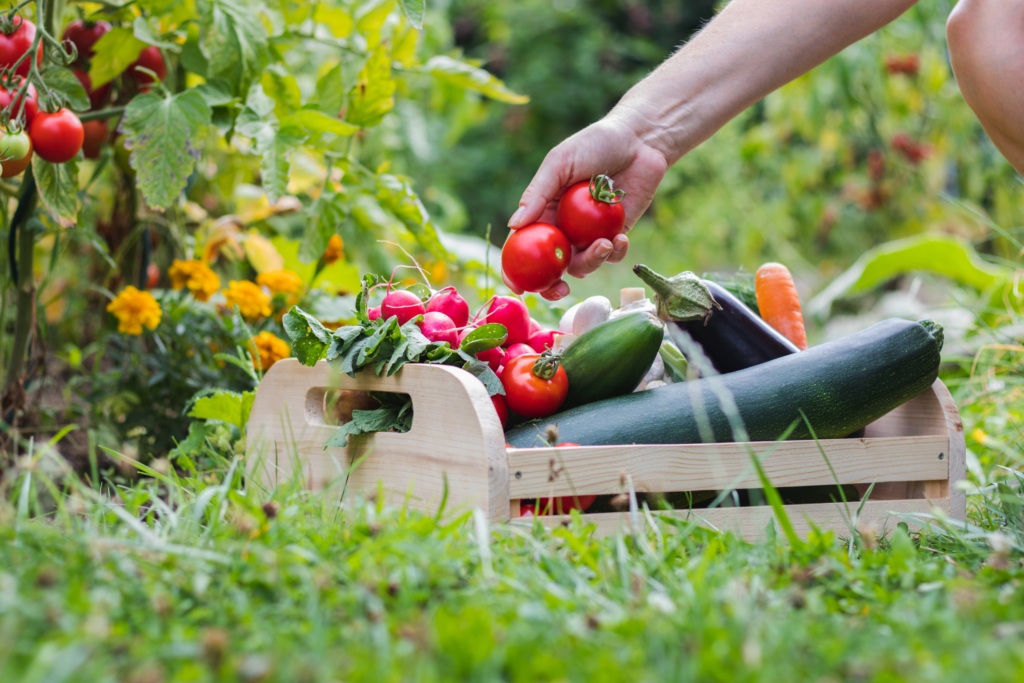
Ruth: Yeah, that’s what scares me about it. I don’t want to start it if I can’t actually maintain it. But I think, people take this approach to everything in life, right? If we can’t do it all the way, then I’m not going to do it at all. And so much about our health in general we do that, right?
We think, if I can’t go all in and I can’t do it perfectly, then why even bother? But that’s not actually the right approach because a little bit is better than nothing. So do a little bit, do what you can. And that’s what you’re saying about this too.
Shelby: Oh, for sure. One of the places where we tell people to start is we have an exercise that we call the five minute refrigerator and pantry challenge, and you set a timer for five minutes. You go through your pantry, you go through your fridge, if you have a written out grocery list, you can look at that also.
But you essentially write down what it is that you’re shopping for every single week at the grocery store. So when I go through this challenge, for me, my top things are like tomatoes and stuff for fresh salads. We use a lot of herbs, garlic, onions, and I look at this and go, okay. This is what we are buying the most of in the grocery store.
What of this can I produce at home? If I were to pick three things, what are the top three things that I could grow in a garden or produce on my homestead? And just taking those top three things and growing them or producing them at home, that in itself makes a massive difference.
So it makes it a lot more sustainable in the long run if you go about it from that point of view.
Ruth: I like that approach. That actually feels really doable.
Shelby: It is totally doable. If you could, I would say block off 10 minutes a day you dedicate to your garden or your chickens, you know, whatever you decide that first starting point is for you. That’s all it takes.
It’s not super complicated or time consuming.
Ruth: I’m feeling inspired. We do eat a lot of eggs. We go through a lot of eggs and eggs have gotten so crazy expensive, like ridiculous. Especially the good ones.
Shelby: Yes. It’s insane. So another thing to consider is the quality of what you’re going to produce at home. It’s insanely better than what you could ever buy in the grocery store, even if you go out of your way to buy “the good stuff.” And most of the produce that you buy in the grocery store, even if you’re buying fresh produce, it’s several months old.
So insert science lesson: a lot of produce… we’ll use tomatoes as an example because this happens so frequently with them… tomatoes, when they are grown commercially, areactually picked when they’re green, before they’re ripe, and they’re stored in these giant warehouses.
Now, as soon as you pick any type of produce, the nutrients in that start to break down within hours. You’re losing vitamins, minerals, carbohydrates, all of the stuff that would give it any nutritional value or flavor starts to break down, whether it is ripe or not. So tomatoes ripen with a natural gas that they produce that’s called ethylene gas.
In these warehouses where they store these unripened tomatoes, they actually pull the ethylene gas out of the air and that prevents the tomatoes from ripening and it kind of puts them in this state of stasis. The nutrients are still breaking down, right? The tomatoes just aren’t ripening. So when they get ready to ship those tomatoes out, they will release ethylene gas into the air and make all the tomatoes ripen at the same time.
So when they get to the grocery store, they’re ripened. They’re red, but they’re nutrient deficient.
So have you ever had a tomato that you bought at the grocery store and you sliced into it and it’s like almost gritty and watery and has no flavor? That tomato was probably over a year old when you got it.
Ruth: No way. That’s crazy.
Shelby: And so, you know, we wonder why, when we look at people that live in blue zones, they’re growing and producing stuff or getting it super locally. It’s not stuff that’s been hanging out in a warehouse where there is no nutritional value in it, right?
Everything that they are eating still has the nutrients in it. It’s still really nutrient dense. And you can get that when you’re producing stuff at home, because you’re picking it fresh, you’re using it fresh, you’re not letting it sit. Could you imagine picking a fresh tomato and then just letting it sit in your pantry for a year, and then trying to eat it?
That’s insane to think that that’s what happens all of the time, and then people wonder why we need multivitamins and supplements to make up the difference because it’s not in our food like it should be.
Ruth: Okay. Now I’m convinced, but like, do you think homesteading is the trend? Like you go on Instagram and everybody’s making their sourdough bread and it’s like having a moment right now. What do you, how do you feel about that?
Shelby: As somebody that grew up this way, it does make me excited to see other people getting on board with it because I feel like for so long, if you used the word homesteading, it did kind of have like this almost crunchy negative connotation with it.
People were like, Oh.
And it’s like, no, we just enjoy real food and the lifestyle, you know, it’s not like we’re trying to set up for the walking dead or anything. From that perspective, I do think it’s interesting. People who would not have been interested in this maybe three or four years ago are starting to see there’s actually something to it.
Honestly, I think a lot of it had to do with when we went through the pandemic. Remember going to the grocery stores and like, there was nothing there. People were freaking out over going to the grocery store to get a bag of spinach and like there was one bag left and it was seven dollars for one of the small bags of spinach. They just price gouged because they could and I think just that brief scare where people realized how fragile commercial food chains and the food supply chain is, that’s when we started to realize that maybe this is a skill that I should learn just in case. I don’t know that it’s a trend that will ever completely be buried.
One of my favorite phrases is once you taste a homegrown tomato, you’ll never go back. There’s nothing like a homegrown tomato.
So I think once people start producing stuff and they taste the difference, they’re hooked.
Ruth: I can see that. I mean, just what you were saying about the food being warehoused for a year and losing all its nutritional value that, to me, when I’m purposely trying to eat nutrient dense food is like, okay, I got to do something different.
So is there a happy medium? Is there a way to do this if you’re not growing all your own food?
Shelby: You start slow. You start with three things, but you still have to buy. Things you have to go to the grocery store for or go with locally grown produce without actually growing it yourself.
There are CSA programs all over the place, which is crop share. So you would buy a share from a farm, and it’s a local farm. Most of these places use sustainable agriculture. They’re growing organically, like they’re checking all the boxes, right? So if you want non-GMO, the organic, and you want stuff that’s actually fresh not packed away in a warehouse.
You can buy into a share like that from a local farm. A lot of these places also do meat, eggs and dairy, and again, they’re checking all the boxes. If you don’t have something like that in your area, farmers markets are another place where you can go. I would just encourage people to look up who your local farmers are because a lot of people don’t realize that farmers are going to produce for whoever they can sell it to.
A lot of times you can get a much better quality product and you’ll know how it was produced. You can find out who the person is that’s producing it, all of the stuff that goes into it, if you buy from your local farmer. And a lot of times it’s cheaper than what you could get the same quality in a grocery store because you’re cutting out all of the middlemen.
Try to steer away from some of that commercially produced stuff as much as possible. I know I read a statistic the other day that blew my mind which says, when you go to the grocery store and you buy a one pound package of ground beef, you assume that it’s from one cow, right?
When you think about the fact that one cow can produce hundreds of pounds of meat, the average package, one pound package of ground beef at the grocery store is made up of 70 different cows.
Ruth: No.
Shelby: Yes. And you don’t know how they’re produced, if they were sick when they were slaughtered or like, you know…
Ruith: Oh, Shelby, you’re making me rethink everything now.
Shelby: It’s, it’s, yeah. The research, when you start digging into some of this stuff and you think about this from a health perspective, it’s scary. It really is. It’s no wonder that we’re struggling with all the health issues as a society that we are.
Ruth: Oh my gosh, we could probably keep talking about this all day, but this would be a very long post. So if people want to find out more or find out more about homesteading and get started, how can they find you?
Shelby: I’m at GardenFarmThrive.com and we have two incredible free resources that I think would help somebody’s homesteading journey in a way that’s easy and actually manageable. We have the Free Seeking Simplicity Masterclass where we actually dig into a lot of what we talked about today and simplify how you can get started with a homestead.
We also have a free guide, The Beginner’s Guide to Homesteading, that walks you through how to get started.
Ruth: Awesome. I love it. This was so helpful. It was so good to talk to you, Shelby. I feel like I learned so much and now I am definitely inspired to get started on creating my own blue zone. Thank you so much. Get those chickens!
I hope you found this topic as fascinating as I did. And if you know someone else who would be interested, please be sure to send it their way. And be sure to sign up for our Flip the Switch Guide below to get started on your own health journey today.
What if you could actually take control of
your health in just 10 days?
It’s not your fault you can’t lose weight as a woman over 40 even though you’ve likely tried literally everything. Your metabolism probably feels broken and your hormones are likely all out of whack.
But you can fix it all with ONE simple change: eliminate sugar. We make it super easy with daily lessons teaching you the science behind what makes us gain weight in our midlife and beyond! Are you ready to get started now?

